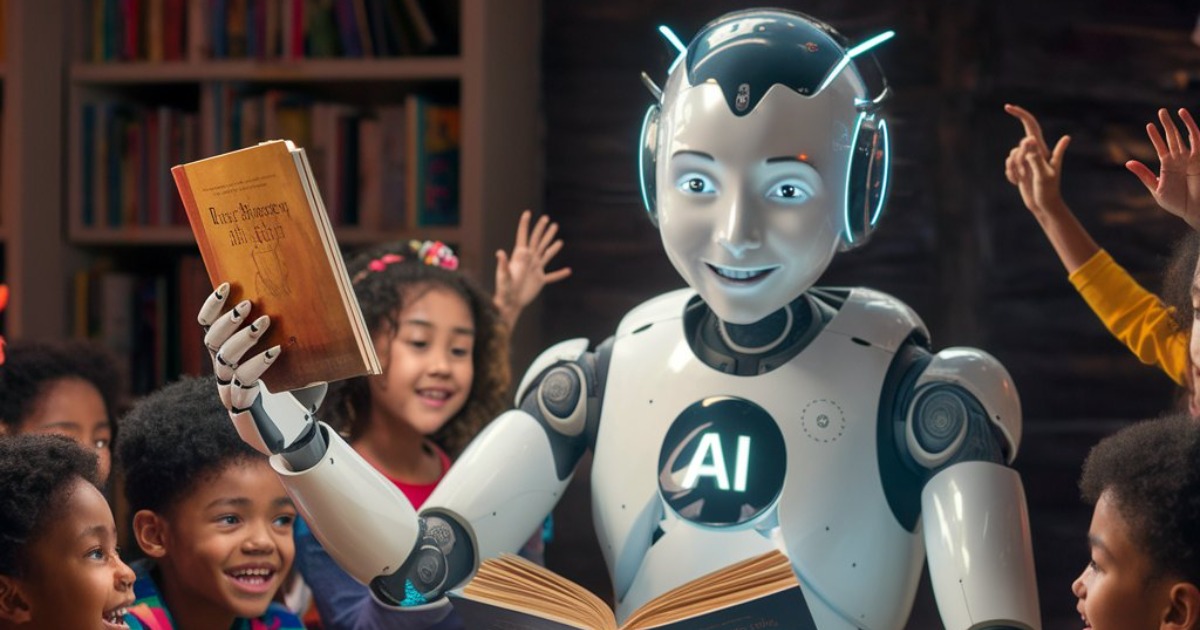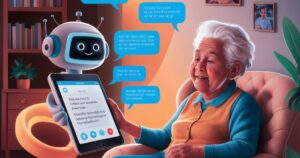In today’s world of digital technology, telling stories goes beyond old limits thanks to technology growth. Artificial Intelligence (AI) has become a force that causes a revolution in the way stories are made, spread, and seen. This detailed guide looks at the exciting area of AI-created storytelling methods checking out how to harness AI to tell stories, what goes on behind AI-created stories, and the tools that help this artistic task. By this article’s end, you will deeply know how AI improves telling stories and how to use these tools for the greatest effect.
How to Use AI for Storytelling?
Using AI to tell stories means putting technology into the creative process to create, boost, or motivate stories. Here’s how you can use AI power for storytelling:
- Idea Generation and Brainstorming: AI tools can help come up with story ideas by looking at trends, themes, and patterns in current stories. Tools like Jasper or ChatGPT can give prompts and ideas helping writers get past creative blocks.
- Character Development: AI can make detailed character profiles using set rules or study existing characters to create new interesting ones. This helps keep characters consistent and deep.
- Plot Structuring: AI programs can study successful story forms and suggest plot moves, twists, and endings. This makes sure the story goes in a clear and interesting way.
- Language and Style Adaptation: AI tools can copy various writing styles and tones letting writers change their stories to suit different genres or audiences. This ability is key to making content that connects with various readers.
- Content Optimization: AI can study reader engagement data and feedback to improve and make stories better for more positive reception. Tools such as Grammarly can offer instant advice to make the writing easier to read and more clear.
How Does AI Create Stories?
AI creates stories using natural language processing, machine machines, and neural connections. Here is a summary of the process:
- Data Input and Analysis: AI systems train on large data sets like books, articles, and scripts. This training lets the AI learn language shades, story layouts, and roles of characters.
- Pattern Recognition: The AI notices common structures in the stories like familiar plot movements, character interactions, and theme parts. This gives it the ability to foresee and form likely story sequences.
- Text Generation: Using methods like GPT, AI creates text by foreseeing the next word or group of words from the scene. This helps it build sentences and sections that make sense and fit the context.
- Story Refinement: AI can make content better by comparing it to other stories and making changes to better flow, consistency, and involvement.
What is the AI-Powered Storytelling Format?
The AI-powered storytelling format involves using AI tools to organize and share stories in a way that maximizes interest and effect. Key parts of this format include:
- Dynamic Plot Development: AI can create plots that change based on reader interactions and likes providing a tailored storytelling experience.
- Interactive Story Elements: AI can add interactive elements like choices, quizzes, and multimedia to increase reader engagement and immersion.
- Adaptive Narratives: AI can change the story’s style and tone to fit the target audience or platform making sure the story connects with readers in various situations.
- Real-Time Feedback Integration: AI tools can gather and study reader feedback right away allowing for ongoing improvements and refinements in the story.
What is the AI Storyteller?
An AI storyteller is a system or tool that uses AI technology to create, generate, or assist in crafting narratives. These systems can vary in complexity, from simple text generators to sophisticated platforms capable of producing intricate and multi-layered stories. Notable examples of AI storytellers include:
- OpenAI’s GPT-4: A powerful language model capable of generating detailed and coherent stories based on given prompts and contexts.
- Jasper AI: A versatile writing assistant that helps create content for various formats, including blogs, scripts, and marketing materials.
- AI Dungeon: An interactive storytelling platform that allows users to create and explore dynamic narratives through AI-generated text.
AI-Generated Storytelling Techniques Free
There are several free AI-generated storytelling techniques that writers can leverage to enhance their creative process:
- Prompt-Based Story Generation: AI tools like ChatGPT can generate story ideas and beginnings based on user-provided prompts, offering a starting point for creative exploration.
- Collaborative Writing Platforms: Free platforms like Google’s Story Speaker enable collaborative storytelling, where users can interact with AI to co-create narratives.
- Story Structuring Tools: Free tools like Plot Generator provide basic story structures and character outlines, helping writers build a solid foundation for their narratives.
AI Storytelling Generator
An AI storytelling generator is a tool that uses AI algorithms to create stories from scratch or based on user inputs. These generators can produce various types of content, from short stories to full-length novels. Key features of AI storytelling generators include:
- Prompt-Based Generation: Users provide a prompt or theme, and the AI generates a story that aligns with the input.
- Customizable Parameters: Users can set parameters such as genre, tone, and character traits to tailor the generated story to specific preferences.
- Iterative Refinement: AI storytelling generators often allow for iterative refinement, enabling users to edit and enhance the generated content for better quality and coherence.
Storytelling AI Free
There are several free AI tools available for storytelling, providing valuable resources for writers and creators. Some notable options include:
- OpenAI’s GPT-3 Playground: Offers a free interface for experimenting with AI-generated text and storytelling.
- Plot Generator: A free tool that helps users create plots, characters, and story settings.
- AI Dungeon: A free-to-use interactive storytelling platform that allows users to explore and create dynamic narratives.
AI Story Conversation
AI story conversation refers to the interactive and dynamic exchange between the AI and the user during the storytelling process. This interaction can involve:
- Real-Time Story Development: Users can guide the narrative direction through choices and inputs, allowing for a personalized storytelling experience.
- Adaptive Feedback: AI provides feedback and suggestions based on user responses, enhancing the story’s coherence and engagement.
- Collaborative Creativity: AI and users collaborate to create unique and compelling narratives, blending human creativity with AI’s analytical capabilities.
AI for Writing Stories
AI can significantly enhance the story-writing process by providing tools and techniques that streamline and enrich the creative journey. Here’s how AI can be used for writing stories:
- Content Generation: AI can generate content based on prompts, themes, and keywords, helping writers overcome creative blocks and explore new ideas.
- Language Enhancement: AI tools can improve the quality of writing by suggesting grammar and style enhancements, ensuring that the story is polished and engaging.
- Story Analysis: AI can analyze story elements such as plot structure, character development, and thematic consistency, providing insights for refinement and improvement.
AI Storytelling Generator
An AI storytelling generator is a device that employs AI algorithms to make stories from nothing or from what users suggest. These generators can create different types of works, from brief tales to entire books. Main functions of AI storytelling generators include:
- Prompt-Based Generation: Users give a prompt or theme, and the AI builds a story that matches the input.
- Customizable Parameters: Users can choose settings like genre, tone, and character qualities to shape the created story to fit their likes.
- Iterative Refinement: AI storytelling generators allow for iterative refinement letting users edit and improve the created work to enhance quality and clarity.
Storytelling AI Free
Many AI tools are free and assist storytellers and creators. Some well-known tools are:
- OpenAI’s GPT-3 Playground: Gives a free space to try AI-driven text and storytelling.
- Plot Generator: A free tool that aids in creating plots, characters, and settings for stories.
- AI Dungeon: A free interactive storytelling platform that lets users create and explore changing stories.
AI Story Conversation
AI story conversation is the active back-and-forth between the AI and the user in storytelling. This interaction can include:
- Real-Time Story Development: Users can guide the story’s path by making choices and entering data making the story experience custom.
- Adaptive Feedback: AI offers feedback and ideas based on what users say making the story better and more engaging.
- Collaborative Creativity: AI and users work together to make new and interesting stories mixing human ideas with AI’s ability to analyze.
AI for Writing Stories
AI can make the story-writing process much better by offering tools and methods that make and improve the creative journey. Here’s how AI can help in writing stories:
- Content Generation: AI can create content based on prompts, themes, and keywords. This helps writers deal with creative blocks and find new ideas.
- Language Enhancement: AI tools can increase the quality of writing by suggesting grammar and style improvements. This ensures that the story is smooth and interesting.
- Story Analysis: AI can study story parts like plot structure, character evolution, and theme consistency. These reviews offer guidance for refining and making the story better.
How to Get AI to Write a Story
To have AI write a story involves using AI tools and systems made to create content. Here is a step-by-step guide:
- Choose the Right Tool: Pick an AI writing tool that fits your needs, like Jasper AI, ChatGPT, or AI Dungeon.
- Provide a Prompt: Give a prompt or theme that lays out the basic premise of the story you want to create.
- Set Parameters: Set parameters such as genre, tone, and character traits to direct the AI in creating the story.
- Generate and Refine: Let the AI create the story and then review and adjust the content to improve quality and coherence.
What is the Best Story-Writing AI?
The best story-writing AI depends on your individual needs and preferences. Here are some top choices:
- Jasper AI: Known to have versatility and the ability to create high-quality content in different formats.
- ChatGPT: Provides advanced language generation skills making it perfect for writing detailed and interesting stories.
- AI Dungeon: Ideal for interactive and lively storytelling, it lets users explore and make unique narratives.
Conclusion
AI-created storytelling is causing a revolution in how stories are made and enjoyed giving new chances for creativity and innovation. By using AI tools and techniques, writers can improve their storytelling skills, make appealing and personal content, and get a wider audience.



